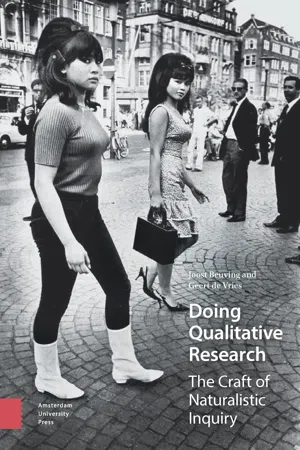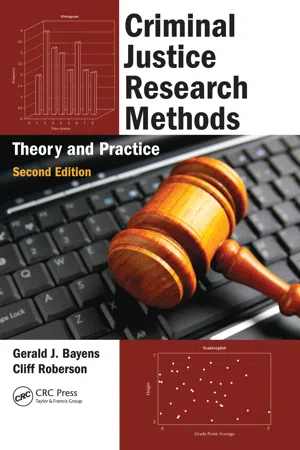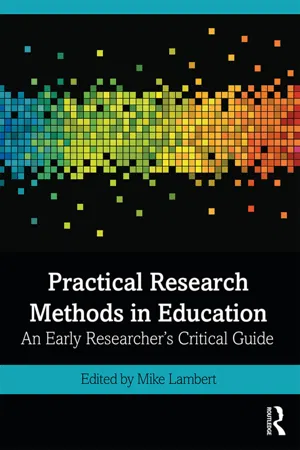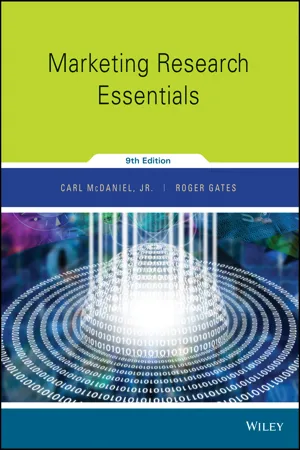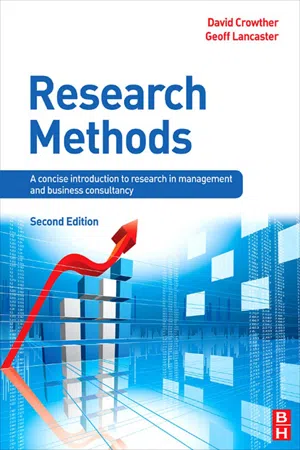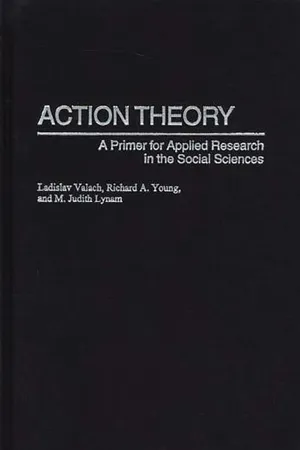Social Sciences
Observation
Observation in social sciences refers to the systematic process of watching, listening, and noting behaviors, events, or phenomena to gather data and gain insights. It involves the objective recording of information without direct interference or manipulation. Observations can be conducted in natural settings or controlled environments and are essential for understanding social interactions, behaviors, and cultural practices.
Written by Perlego with AI-assistance
Related key terms
1 of 5
12 Key excerpts on "Observation"
- eBook - ePub
Using Research Instruments
A Guide for Researchers
- Peter Birmingham, David Wilkinson(Authors)
- 2003(Publication Date)
- Routledge(Publisher)
Observation, and one of the clearest basic definitions we have found of Observation as a research method tells us that it is ‘research characterised by a prolonged period of intense social interaction between the researcher and the subjects, in the milieu of the latter, during which time data, in the form of field notes, are unobtrusively and systematically collected’ (Bogdan 1972: 3). We refer to social scientific research of this kind throughout this chapter as ‘Observation’, although we make no real distinction between Observation and ‘ethnography’–literally ‘writing about people’. You may come across the term ethnography frequently. It describes essentially the same practice but one which has its roots more in anthropology than in social science.Why choose Observation?
Social researchers are interested in people and, in particular, the ways in which people act in, interpret and understand the complex world around them, whether that is the world of the classroom, the hospital, the factory floor, the head office, the local government department or wherever. How people see and understand their surroundings will no doubt play a part in the ways in which they behave, they act and interact with others, and in the ways their actions are perceived by others. Observation is an extremely handy tool for researchers in this regard. It can allow researchers to understand much more about what goes on in complex real-world situations than they can ever discover simply by asking questions of those who experience them (no matter how probing the questions may be), and by looking only at what is said about them in questionnaires and interviews. This may be because interviewees and questionnaire respondents are sometimes reluctant to impart everything they know, perhaps feeling it would be improper or insensitive to do so, or because they consider some things to be insignificant or irrelevant. It is more likely the case, however, that they are unable - Olga Moreira(Author)
- 2023(Publication Date)
- Arcler Press(Publisher)
Qualitative methods of data collection, such as interviewing, Observation, and document analysis, have been included under the umbrella term of “ethnographic methods” in recent years. The purpose of this paper is to discuss Observation, particularly participant Observation, as a tool for collecting data in qualitative research studies. Aspects of Observation discussed herein include various definitions of participant Observation, some history of its use, the purposes for which such Observation is used, the stances or roles of the observer, and additional information about when, what, and how to observe. Further information is provided to address keeping field notes and their use in writing up the final story. [1] DEFINITIONS MARSHALL and ROSSMAN (1989) define Observation as “the systematic description of events, behaviors, and artifacts in the social setting chosen for study” (p.79). Observations enable the researcher to describe existing situations using the five senses, providing a “written photograph” of the situation under study (ERLANDSON, HARRIS, SKIPPER, & ALLEN, 1993). DeMUNCK and SOBO (1998) describe participant Observation as the primary method used by anthropologists doing fieldwork. Fieldwork involves “active looking, improving memory, informal interviewing, writing detailed field notes, and perhaps most importantly, patience” (DeWALT & DeWALT, 2002, p.vii). Participant Observation is the process enabling researchers to learn about the activities of the people under study in the natural setting through observing and participating in those activities. It provides the context for development of sampling guidelines and interview guides (DeWALT & DeWALT, 2002). SCHENSUL, SCHENSUL, and LeCOMPTE (1999) define participant Observation as “the process of learning through exposure to or involvement in the day-to-day or routine activities of participants in the researcher setting” (p.91). [2]- eBook - PDF
Doing Qualitative Research
The Craft of Naturalistic Inquiry
- Joost Beuving, Geert de Vries(Authors)
- 2015(Publication Date)
- Amsterdam University Press(Publisher)
3. Looking at society: Observing, participating, interpreting The eyes see only what the mind is prepared to comprehend – Henri Louis Bergson The following four chapters explore dif ferent strategies for the collection of information about society, and we begin our discussion by talking about Observations. Observations hold a special place in naturalistic inquiry. This follows directly from the ambition of naturalistic inquiry to minimally disturb, or frame, social life in a research situation, but instead to look at how it unfolds under ordinary conditions. Looking around us – at our fellow humans, at ‘society’, and so on – is something we do all the time and is an important part of everyday life. We therefore subscribe to a broad defin ition of observing, see Box 7. However, our tacit familiarity with Observation in everyday life may at the same time stand in the way of using it as a tool for explicit understanding. Looking at society is neither a self-evident nor a straightforward enterprise. There are pitfalls to consider and mental and practical obstacles to overcome. This chapter tries to shed light on those, inviting you to make Observation a prime source for telling about a society. After briefly exploring the Enlightenment roots of Observations in social science, the chapter discusses this in the context of positivism and natu-ralistic inquiry. It will be shown that the term ‘Observation’ has a dif ferent meaning in these two traditions, and thus it results in dif ferent ways of practicing it. The chapter further explores how the ambition of naturalistic researchers to get close to the members of a society that they are studying has consequences for how and what they observe: if they participate in society, are their Observations then not f iltered through the position that the researchers acquire or are attributed? This refers to a problem usually referred to as ‘reflexivity’ in social research discourse. - eBook - PDF
Criminal Justice Research Methods
Theory and Practice, Second Edition
- Gerald J. Bayens, Cliff Roberson(Authors)
- 2017(Publication Date)
- Routledge(Publisher)
They want to know the advantages and disadvan-tages of traditional methods and how new approaches affect the quality of service delivery. Most importantly, people want to know what is really going on between the police and the pub-lic. This report describes systematic social Observation, a field research method well suited to answer many questions posed about policing today. WHAT IS SYSTEMATIC SOCIAL Observation? Observation is fundamental to all forms of data collection. The forms differ primarily in how techniques of investigation are organized, how Observations are made and recorded, and in their validity and reliability. Systematic Observation of natural social phenomena (systematic social Observation or SSO) has specific features. First, researchers observe the object of study in its “natural” setting; for example, they may observe directly how an officer responds to a citizen’s request for service by being present as the officer interacts with the citizen. SSO requires that the researcher see and hear an event directly without relying upon others to describe it. Second, researchers make and record their Observations according to procedures that can be duplicated. These procedures are made explicit before Observation and may be followed by other researchers to produce the same results when they observe the same event. For example, if a researcher wants to know whether an officer was respectful to a complainant, the researcher must define respectful and complainant in such a way that if other 146 criminal justice research methods: theory and practice researchers were to follow these rules observing the same situ-ation, they would use the same criteria. This makes it possible for many researchers to conduct Observations, rather than rely-ing only upon the Observations of a single researcher. Third, these rules are constructed so that researchers can use them to make scientific inferences. - eBook - PDF
- Carl McDaniel, Jr., Roger Gates, Subramanian Sivaramakrishnan, Kelley Main(Authors)
- 2013(Publication Date)
- Wiley(Publisher)
A marketing researcher using the Observation technique witnesses and records events as they occur or compiles evidence from records of past events. The Observation may involve watching people or watching phenomena, and it may be conducted by human observers or by machines. Exhibit 5.1 gives examples of these various observa- tion situations. Observation research A systematic process of recording patterns of occurrences or behav- iours without normally communi- cating with the people involved. 115 The Nature of Observation Research CONDITIONS FOR USING Observation Three conditions must be met before Observation can be successfully used as a data col- lection tool for marketing research: 1. The needed information must be either observable or inferable from behaviour that is observable. For example, if a researcher wants to know why an individual pur- chased a new Jeep rather than an Explorer, Observation research will not provide the answer. 2. The behaviour of interest must be repetitive, frequent, or in some manner pre- dictable. Otherwise, the costs of Observation may make the approach prohibitively expensive. 3. The behaviour of interest must be of relatively short duration. Observation of the entire decision-making process for purchasing a new home, which might take sev- eral weeks or months, is not feasible. APPROACHES TO Observation RESEARCH Researchers have a variety of Observation approaches to choose from. They have the task of choosing the most effective approach for a particular research problem, from the stand- point of cost and data quality. The dimensions along which Observation approaches vary are (1) natural versus contrived situations, (2) open versus disguised Observation, (3) human versus machine observers, and (4) direct versus indirect Observation. Natural versus Contrived Situations Counting how many people use the drive-in window at a particular bank during certain hours is a good example of a completely natural situation. - eBook - PDF
Practical Research Methods in Education
An Early Researcher's Critical Guide
- Mike Lambert(Author)
- 2019(Publication Date)
- Routledge(Publisher)
Chapter 3 Observations Tunde Rozsahegyi Introduction Following the discussion of questionnaires and interviews in the preceding chapters, here we explore the third of the most commonly used data-collection methods: Observation. In contrast with the two others, both of which draw out the perceptions and opinions of research participants, Observation offers a direct opportunity to gain closer understanding of what actually happens in real life. Not only are Observations an illuminating data source, they can also be particularly rewarding, for both novice and more experienced researchers. A chapter in Basit (2010) has the title: ‘The charm of gathering data in situ’, and Delamont (2016:102) reflects at length on the highly satisfying, multi-sensory nature of this method: I always want to stand or sit and watch something. The data gathered slowly by watching … are for me the sweetest jams and most aromatic oils and spices. Whenever I hear about a project, I want to go and sit there myself … As well as looking, use your ears, touch everything you can and pay attention to all bodily sensations such as heat and cold, smell the fieldsite, and when feasible, taste things. Despite these attractions, however, utilizing the potential of Observation and applying its processes in meaningful ways require considerable methodological and ethical deliberation. This chapter discusses these considerations. It does this firstly by outlining the purpose of Observation as a data-gathering method in educational enquiry, explaining different types of Observations which can be undertaken and illustrating ways of recording the resulting data. Specific issues of validity and ethics are also addressed. Issues are then revisited in a more practical way in the second part of the chapter, which shares the rationale and processes which I applied in my doctoral study. - eBook - ePub
Practical Research Methods in Education
An Early Researcher's Critical Guide
- Mike Lambert(Author)
- 2019(Publication Date)
- Routledge(Publisher)
Chapter 3Observations Tunde RozsahegyiIntroductionFollowing the discussion of questionnaires and interviews in the preceding chapters, here we explore the third of the most commonly used data-collection methods: Observation. In contrast with the two others, both of which draw out the perceptions and opinions of research participants, Observation offers a direct opportunity to gain closer understanding of what actually happens in real life.Not only are Observations an illuminating data source, they can also be particularly rewarding, for both novice and more experienced researchers. A chapter in Basit (2010) has the title: ‘The charm of gathering data in situ’, and Delamont (2016:102) reflects at length on the highly satisfying, multi-sensory nature of this method:I always want to stand or sit and watch something. The data gathered slowly by watching … are for me the sweetest jams and most aromatic oils and spices. Whenever I hear about a project, I want to go and sit there myself … As well as looking, use your ears, touch everything you can and pay attention to all bodily sensations such as heat and cold, smell the fieldsite, and when feasible, taste things.Despite these attractions, however, utilizing the potential of Observation and applying its processes in meaningful ways require considerable methodological and ethical deliberation. This chapter discusses these considerations. It does this firstly by outlining the purpose of Observation as a data-gathering method in educational enquiry, explaining different types of Observations which can be undertaken and illustrating ways of recording the resulting data. Specific issues of validity and ethics are also addressed. Issues are then revisited in a more practical way in the second part of the chapter, which shares the rationale and processes which I applied in my doctoral study. You are encouraged to apply ideas discussed in this chapter critically to your own research and to consider how Observation, if appropriate, might be employed to address the research questions in your own investigation. - eBook - PDF
- Carl McDaniel, Jr., Roger Gates(Authors)
- 2016(Publication Date)
- Wiley(Publisher)
LEARNING OBJECTIVES 1. Develop a basic understanding of Observation research. 2. Learn the approaches to Observation research. 3. Understand the types of machine Observation. 4. Appreciate how online tracking is changing and its growing use in social media. 5. Learn how virtual shopping environments are created and used in marketing research. 7 C H A P T E R Primary Data Collection: Observation Denis Zbukarev/iStockphoto 126 CHAPTER 7 Primary Data Collection: Observation W hat is Observation research, and how is it used in marketing research? What is ethnography, and why is it so popular? Observation research has exploded on the Internet and social media. Why? Why is online Observation research so controversial? What are the machines that can be used in Observation research, and what kind of data do they produce? We will answer these questions in this chapter. Nature of Observation Research Instead of asking people questions, as a survey does, Observation research depends on watching what people do. Specifically, Observation research can be defined as the systematic process of recording patterns of occurrences or behaviors without normally questioning or communicating with the people involved. (Mystery shopping is an exception.) A marketing researcher using the Observation technique witnesses and records events as they occur or compiles evidence from records of past events. The Observation may involve watching people or watching phenomena, and it may be conducted by human observers or by machines. Exhibit 7.1 gives examples of some common Observation situations. E X H I B I T 7 . 1 Observation Situations Situations Example People watching people Observers stationed in supermarkets watch consumers select frozen Mexican dinners, with the purpose of seeing how much comparison shopping people do at the point of purchase. People watching phenomena Observers stationed at an intersection count vehicles moving in various directions to establish the need for a traffic light. - eBook - ePub
- David Crowther, Geoff Lancaster(Authors)
- 2012(Publication Date)
- Routledge(Publisher)
While we are considering the collection of data in these chapters we must also bear in mind that all data collected needs also to be analyzed. These two aspects of research inevitably go together, although we will treat them separately by devoting chapters firstly to collection and then to analysis. At this point therefore it is merely important to note that the two actions – collection and analysis – go together but that there are a number of different ways in which any type of data can be analyzed so it is selecting the right combination which is important. This is particularly important to bear in mind as we consider the respective benefits and disadvantages of each method of data collection and data analysis. We will of course be returning to this later.8.1 The Nature and Purpose of Observational ResearchObservational research has a long and increasingly distinguished history, particularly in the social sciences. In the most general sense, Observational research comprises of collecting primary data through looking and noting. As you would expect with such a general description, the nature, scope, and types of Observational research vary enormously. We shall group Observational research into a number of key categories using first of all the extent to which the Observations are systematic or relatively unstructured and secondly the extent to which the observer is a participant or remains an outside observer. However, we must then query the background to this approach to data collection.As already mentioned, Observational research has a long history. In the physical sciences, amongst some of the most notable applications of Observational research would include, for example, Sir Isaac Newton’s Observation of the apple falling which, it is said, led eventually to Newton’s laws of gravity and motion. Similarly, the Observations of the medieval astronomers led to significant developments in our knowledge about the universe and its workings. Observational techniques in the social sciences, in any systematic sense that is, have something of a shorter but no less distinguished history. In particular, as we shall see later, Observational research has long been a major tool of data collection in the fields of sociology and anthropology but has now become one of the major tools of research in management and organizations. In the area of management and organizational research one of the earliest uses of Observation as a research methodology was the study by Charles Booth in the United Kingdom in the 19th century. Booth used Observational techniques, in conjunction with other techniques, to study the working people of London in the 1880s. It was probably, however, during the 1950s that the potential value of Observational research as a method of data collection in the management/organizational field began to be recognized and there have been many now classic studies in the area of management research using this technique. Examples would include Roy’s (1952) study of work in a machine shop; Gouldner’s (1954) research into aspects of bureaucracy in a gypsum mine; Lupton’s (1963) study of output restriction by employees in two manufacturing plants; the extremely influential research of Minzberg (1973) with his Observational-based research on management activities in organizations; Benyon’s (1973) extended studies of events and problems at the Ford Halewood plant over a 5-year period; and, more recently, the Observational research of Rosen (1991) that was conducted in a Philadelphian advertising agency. As a method of data collection, Observational research continues to grow in importance. So what explains this increasing use of Observational research, particularly in the area of management and organizational research and, more specifically, what are the advantages of Observational approaches to collecting primary data? The following represent some of the major suggested advantages associated with Observational research techniques: - eBook - PDF
Methods of Social Research
Pergamon International Library of Science, Technology, Engineering and Social Studies
- Margaret Stacey(Author)
- 2013(Publication Date)
- Pergamon(Publisher)
C H A P T E R 4 Observation T H E methods of Observation used in the social sciences fall into t w o main groups; participant and non-participant. In the former case the observer joins the group he is studying as a m e m b e r and attempts to be at one and the same time one of the observed as well as the observer. In the second case the observer is where his subjects are but is not one of them and is not joining fully, and perhaps not at all, in their life. In some cases, as that of observing through a o n e -w a y screen, the subjects are not even aware that they are being observed or, if aware, are not disturbed. This m e t h o d is sometimes employed by psychologists, watching children at play, and has also been used by sociologists in the study of small groups. In most cases of direct non-participant Observation the observed are aware that they are observed. In practice it is often not possible to d r a w a hard and fast line between participant and non-participant Observation, for t w o reasons. O n e , the research w o r k e r m a y use both methods at once, and t w o , the participation is almost always partial, the difference lying principally in the a m o u n t of participation sought or achieved. P A R T I C I P A N T O B S E R V A T I O N This is the n a m e which was given in 1924 by Eduard C. Lindeman in Social Discovery where he criticized the questionnaire method saying: If y o u wish to k n o w w h a t a person is really doing, watch h i m . , , ( 1 ) Participant Observation m a y be open or concealed. That is a person m a y go to w o r k in a factory (say) for research purposes and not reveal that that is w h y he is there. O r he m a y apply for a 5 0 Observation 51 j o b saying openly that he is going to do research on the workshop relations in the factory while he is w o r k i n g there. - eBook - PDF
Action Theory
A Primer for Applied Research in the Social Sciences
- Ladislav Valach, Richard A. Young, M. Judith Lynam(Authors)
- 2002(Publication Date)
- Praeger(Publisher)
It is another empirical approach in addition to naive Observation and subjective reports. Although considered too time consuming by many, systematic Observation is the method by which Renaissance thoughts and constructions were initiated and developed. How- ever, modern psychological Observation research left the path of broad de- scriptive Observation, often called botanizing, and became a very specialized, detailed, and elaborate method. Coding of nonverbal aspects of facial expres- sion (Ekman & Friesen, 1975) as well as analyzing linguistic notations of conversation openings (conversation analysis) (Schegloff & Sacks, 1973) were topics frequently investigated under the rubric of specialized psychological research. In these approaches many physically defined Observational units are used in which such aspects as the extent, direction, or position are re- corded in terms of time or unit of length (for example, in centimeters or de- grees). At that time the notation of meaningful behavioral or action units was found in ecological psychology, in the tradition of Barker and Wright (1951, 1955), and in ethnography (Vidich & Lyman, 1994). Coding of functional steps is mostly used in ethology (Hinde, 1982) and group research (Bales & Cohen, 1979). The corresponding categories for an Observational system and quality criteria are indicated in Figure 1.7. Target processes such as facial expression or conversations, which have been addressed by the researchers identified, can be integrated to the action system, as illustrated in Figure 1.8. In dealing with meaningful actions in environmental settings, socially de- fined categories are used. These categories represent consensual labels even naive observers agree upon. In Observation of the lowest-order behavioral elements, structurally defined units using physical measures are employed. In coding sequences of steps directed either toward goals or adaptational tar- gets, functional categories are used. - eBook - PDF
Qualitative Research for the Information Professional
A Practical Handbook
- G E Gorman, Peter Clayton(Authors)
- 2004(Publication Date)
- Facet Publishing(Publisher)
(This too is considered in more detail later in this chapter.) Careful, considered use of unstructured Observation as a technique can help make best advantage of its strengths as a data collection technique and minimize, so far as possible, most of these inherent limitations. Characteristics of Observation in information settings In the information professions, unstructured Observation as a qualitative research method has a number of important characteristics. These include its variety of possible researcher perspectives, its present orientation, and its reality-verifying character. This section discusses each of these in turn. Observation 105 Variety of researcher perspectives As the overview of Observation in Chapter 1 indicated, as a data collection technique Observation can be unobtrusive, structured or participant. In fact, it does not consist of a set of discrete choices made by the researcher but appears rather as a range of flexible positions in a continuum of participatory involvement, moving from unobtrusive observer, through observer-as-participant and then participant-as-observer to complete participant (see Figure 7.1). 2 As an unobtrusive observer the researcher functions, to the extent that this is possible, as a cipher, a simple recorder of events. In this capacity the researcher has little or no interaction with the people or events being observed. For example, a researcher may simply sit at a table in the reference section and watch how users and reference librarians interact, making detailed notes on the interactions. The researcher does not participate in any way in the interactions being observed, and none of the participants is made aware of the researcher’s presence. Observer-as-participant and participant-as-observer are perhaps subtle variations on a theme, with one role merging imperceptibly into the other.
Index pages curate the most relevant extracts from our library of academic textbooks. They’ve been created using an in-house natural language model (NLM), each adding context and meaning to key research topics.


